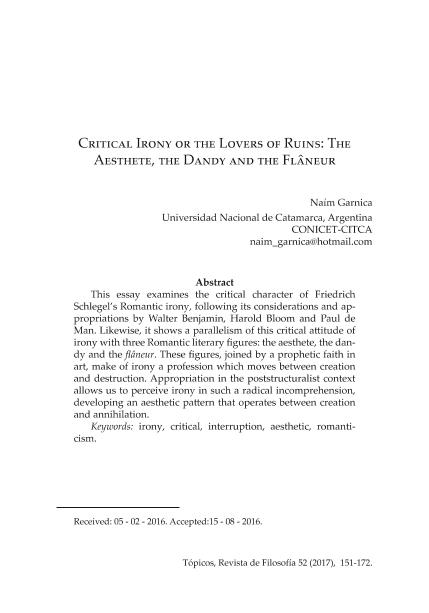Artículo
El ensayo examina el carácter crítico de la ironía romántica de Friedrich Schlegel siguiendo las consideraciones y apropiaciones de Walter Benjamin, Harold Bloom y Paul de Man. También, el ensayo pretende mostrar el paralelismo de la actitud crítica de la ironía con tres figuras literarias románticas: el esteta, el dandy y el flâneur. Estas criaturas, unidas por una fe profética en el arte, hacen de la ironía una profesión que se mueve entre la creación y la destrucción. La apropiación en el contexto post-estructuralista nos permite percibir a la ironía en una incomprensión radical, desarrollando un patrón estético que opera entre la creación y la aniquilación. This essay examines the critical character of FriedrichSchlegel?s Romantic irony, following its considerations and appropriationsby Walter Benjamin, Harold Bloom and Paul deMan. Likewise, it shows a parallelism of this critical attitude ofirony with three Romantic literary figures: the aesthete, the dandyand the flâneur. These figures, joined by a prophetic faith inart, make of irony a profession which moves between creationand destruction. Appropriation in the poststructuralist contextallows us to perceive irony in such a radical incomprehension,developing an aesthetic pattern that operates between creationand annihilation.
Critical Irony or the Lovers of Ruins: The Aesthete, the Dandy and the Flâneur
Título:
La ironía crítica o los amantes de las ruinas: el esteta, el dandy y el flâneur
Fecha de publicación:
12/2016
Editorial:
Centros Culturales de México
Revista:
Tópicos
ISSN:
0188-6649
e-ISSN:
2007-8498
Idioma:
Inglés
Tipo de recurso:
Artículo publicado
Clasificación temática:
Resumen
Palabras clave:
Ironía
,
Romanticismo
,
Postestructuralismo
,
Estética
,
Crítica
Archivos asociados
Licencia
Identificadores
Colecciones
Articulos(SEDE CENTRAL)
Articulos de SEDE CENTRAL
Articulos de SEDE CENTRAL
Citación
Garnica, Naím; Critical Irony or the Lovers of Ruins: The Aesthete, the Dandy and the Flâneur; Centros Culturales de México; Tópicos; 52; 12-2016; 151-172
Compartir
Altmétricas




